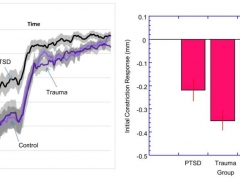- 具有强迫思维、强迫行为,或两者皆有。
强迫思维被定义为如下,- 在该障碍的某些时间段内,感受到反复的、持续性的、侵入性的和不必要的想法、冲动或意向,大多数个体会引起的或痛苦。
- 个体试图忽略或压抑此类想法、冲动或意向,或用其他些想法或行为来中和它们(例如,通过某种强迫行为。
- 重复行为(例如,洗手、排序、核对)或精神活动(例如,祈祷、反复默诵字词)。个体感到重复行为或精神活动是作为应对强迫思维或根据必须严格执行的规则而被迫执行的。
- 重复行为或精神活动的目的是防止或减少焦虑或痛苦,或防止某些可怕的事件或情况;然而,这些重复行为或精神活动与所设计的中和或预防的事件或情况缺乏现实的连接,或者明显是过度的。
注:幼儿可能不能明确地表达这些重复行为或精神活动的目的。
- 强迫思维或强迫行为是耗时的(例如,每天消耗1小时以上)或者写症状引起具有临床意义的痛苦,或导致社交、职业或其他重要功能方面的损害。
- 此强迫症状不能归因于某种物质(例如,滥用的毒品、药物)的生理效应或其他躯体疾病。
- 该障碍不能用其他精神障碍的症状来更好地解释[例如,像广泛性焦虑障碍中的过度担心,像躯体变形障碍中的外貌先占观念,像固积障碍中的难以丢弃或放弃物品,像拔毛癖[拔毛障碍]中的拔毛发,像抓痕[皮肤搔抓]障碍中的皮肤搔抓,像刻板运动障碍中的刻板行为,像进食障碍中的仪式化进食行为,像物质相关及成瘾障碍中物质或赌博的先占观念,像疾病焦虑障碍中患有某种疾病的先占观念,像性欲倒错障碍中的性冲动或性幻想,像破坏性、冲动控制及品行障碍中的冲动,像重性障碍中的内疚性沉思,像精神分裂症谱系及其他性障碍中的思维插入或妄想性的先占观念,或像()谱系障碍中的重复性行为模式]。
标注如果是:
伴良好或一般的自知力:个体意识到强迫症的信念肯定或可能不是真的,或者它们可以是或可以不是真的。
伴差的自知力:个体意识到强迫症的信念可能是真的。
缺乏自知力/妄想信念:个体完全确信强迫症的信念是真的。
标注如果是:
与抽动症相关:个体目前有或过去有抽动障碍史。
Specifiers
Many individuals with obsessive-compulsive disorder (OCD) have dysfunctional beliefs. These beliefs can include an inflated sense of responsibility and the tendency to overestimate threat; perfectionism and intolerance of uncertainty; and over-importance of thoughts (e.g., believing that having a forbidden thought is as bad as acting on it) and the need to control thoughts.
Individuals with OCD vary in the degree of insight they have about the accuracy of the beliefs that underlie their obsessive-compulsive symptoms. Many individuals have good or fair insight (e.g., the individual believes that the house definitely will not, probably will not, or may or may not bum down if the stove is not checked 30 times). Some have poor insight (e.g., the individual believes that the house will probably burn down if the stove is not checked 30 times), and a few (4% or less) have absent insight/delusional beliefs (e.g., the individual is convinced that the house will bum down if the stove is not checked 30 times). Insight can vary within an individual over the course of the illness. Poorer insight has been linked to worse long-term outcome.
Up to 30% of individuals with OCD have a lifetime tic disorder. This is most common in males with onset of OCD in childhood. These individuals tend to differ from those without a history of tic disorders in the themes of their OCD symptoms, comorbidity, course, and pattem of familial transmission.
Diagnostic Features
The characteristic symptoms of OCD are the presence of obsessions and compulsions (Criterion A). Obsessions are repetitive and persistent thoughts (e.g., of contamination), images (e.g., of violent or horrific scenes), or urges (e.g., to stab someone). Importantly, obsessions are not pleasurable or experienced as voluntary: they are intrusive and unwanted and cause marked distress or anxiety in most individuals. The individual attempts to ignore or suppress these obsessions (e.g., avoiding triggers or using thought suppression) or to neutralize them with another thought or action (e.g., performing a compulsion). Compulsions (or rituals) are repetitive behaviors (e.g., washing, checking) or mental acts (e.g., counting, repeating words silently) that the individual feels driven to perform in response to an obsession or according to rules that must be applied rigidly. Most individuals with OCD have both obsessions and compulsions. Compulsions are typically performed in response to an obsession (e.g., thoughts of contamination leading to washing rituals or that something is incorrect leading to repeating rituals until it feels "just right")· The aim is to reduce the distress triggered by obsessions or to prevent a feared event (e.g., becoming ill). However, these compulsions either are not connected in a realistic way to the feared event (e.g., arranging items symmetrically to prevent harm to a loved one) or are clearly excessive (e.g., showering for hours each day). Compulsions are not done for pleasure, although some individuals experience relief from anxiety or distress.
Criterion B emphasizes that obsessions and compulsions must be time-consuming (e.g., more than 1 hour per day) or cause clinically significant distress or impairment to warrant a diagnosis of OCD. This criterion helps to distinguish the disorder from the occasional intmsive thoughts or repetitive behaviors that are common in the general population (e.g., double-checking that a door is locked). The frequency and severity of obsessions and compulsions vary across individuals with OCD (e.g., some have mild to moderate symptoms, spending 1-3 hours per day obsessing or doing compulsions, whereas others have nearly constant intmsive thoughts or compulsions that can be incapacitating).
Associated Features Supporting Diagnosis
The specific content of obsessions and compulsions varies between individuals. However, certain themes, or dimensions, are common, including those of cleaning (contamination obsessions and cleaning compulsions); symmetry (symmetry obsessions and repeating. ordering, and counting compulsions); forbidden or taboo thoughts (e.g., aggressive, sexual, or religious obsessions and related compulsions); and harm (e.g., fears of harm to oneself or others and checking compulsions). Some individuals also have difficulties discarding and accumulate (hoard) objects as a consequence of typical obsessions and compulsions, such as fears of harming others. These themes occur across different cultures, are relatively consistent over time in adults w^ith the disorder, and may be associated v^ith different neural substrates. Importantly, individuals often have symptoms in more than one dimension.
Individuals with OCD experience a range of affective responses when confronted with situations that trigger obsessions and compulsions. For example, many individuals experience marked anxiety that can include recurrent panic attacks. Others report strong feelings of disgust. While performing compulsions, some individuals report a distressing sense of "incompleteness" or uneasiness until things look, feel, or sound "just right." It is common for individuals with the disorder to avoid people, places, and things that trigger obsessions and compulsions. For example, individuals with contamination concerns might avoid public situations (e.g., restaurants, public restrooms) to reduce exposure to feared contaminants; individuals with intrusive thoughts about causing harm might avoid social interactions.
Prevalence
The 12-month prevalence of OCD in the United States is 1.2%, with a similar prevalence internationally (1.1%-1.8%). Females are affected at a shghtly higher rate than males in adulthood, although males are more commonly affected in childhood.
Development and Course
In the United States, the mean age at onset of OCD is 19.5 years, and 25% of cases start by age 14 years. Onset after age 35 years is unusual but does occur. Males have an earlier age at onset than females: nearly 25% of males have onset before age 10 years. The onset of symptoms is typically gradual; however, acute onset has also been reported.
If OCD is untreated, the course is usually chronic, often with waxing and waning symptoms. Some individuals have an episodic course, and a minority have a deteriorating course. Without treatment, remission rates in adults are low (e.g., 20% for those reevaluated 40 years later). Onset in childhood or adolescence can lead to a lifetime of OCD. However, 40% of individuals with onset of OCD in childhood or adolescence may experience remission by early adulthood. The course of OCD is often complicated by the co-occurrence of other disorders (see section "Comorbidity" for this disorder).
Compulsions are more easily diagnosed in children than obsessions are because compulsions are observable. However, most children have both obsessions and compulsions (as do most adults). The pattern of symptoms in adults can be stable over time, but it is more variable in children. Some differences in the content of obsessions and compulsions have been reported when children and adolescent samples have been compared with adult samples. These differences likely reflect content appropriate to different developmental stages (e.g., higher rates of sexual and religious obsessions in adolescents than in children; higher rates of harm obsessions [e.g., fears of catastrophic events, such as death or illness to self or loved ones] in children and adolescents than in adults).
Risk and Prognostic Factors
Temperamental.Greater internalizing symptoms, higher negative emotionality, and behavioral inhibition in childhood are possible temperamental risk factors.
Environmental.Physical and sexual abuse in childhood and other stressful or traumatic events have been associated with an increased risk for developing OCD. Some children may develop the sudden onset of obsessive-compulsive symptoms, v^hich has been associated with different environmental factors, including various infectious agents and a post-infectious autoimmune syndrome.
Genetic and physiological.The rate of OCD among first-degree relatives of adults with OCD is approximately two times that among first-degree relatives of those without the disorder; however, among first-degree relatives of individuals with onset of OCD in childhood or adolescence, the rate is increased 10-fold. Familial transmission is due in part to genetic factors (e.g., a concordance rate of 0.57 for monozygotic vs. 0.22 for dizygotic twins). Dysfunction in the orbitofrontal cortex, anterior cingulate cortex, and striatum have been most strongly implicated.
Culture-Related Diagnostic issues
OCD occurs across the world. There is substantial similarity across cultures in the gender distribution, age at onset, and comorbidity of OCD. Moreover, around the globe, there is a similar symptom structure involving cleaning, symmetry, hoarding, taboo thoughts, or fear of harm. However, regional variation in symptom expression exists, and cultural factors may shape the content of obsessions and compulsions.
Gender-Related Diagnostic issues
Males have an earlier age at onset of OCD than females and are more likely to have comorbid tic disorders. Gender differences in the pattern of symptom dimensions have been reported, with, for example, females more likely to have symptoms in the cleaning dimension and males more likely to have symptoms in the forbidden thoughts and symmetry dimensions. Onset or exacerbation of OCD, as well as symptoms that can interfere with the mother-infant relationship (e.g., aggressive obsessions leading to avoidance of the infant), have been reported in the péripartum period.
Suicide Risk
Suicidal thoughts occur at some point in as many as about half of individuals with OCD. Suicide attempts are also reported in up to one-quarter of individuals with OCD; the presence of comorbid major depressive disorder increases the risk.
Functional Consequences of Obsessive-Compulsive Disorder
OCD is associated with reduced quality of life as well as high levels of social and occupational impairment. Impairment occurs across many different domains of life and is associated with symptom severity. Impairment can be caused by the time spent obsessing and doing compulsions. Avoidance of situations that can trigger obsessions or compulsions can also severely restrict functioning. In addition, specific symptoms can create specific obstacles. For example, obsessions about harm can make relationships with family and friends feel hazardous; the result can be avoidance of these relationships. Obsessions about symmetry can derail the timely completion of school or work projects because the project never feels "just right," potentially resulting in school failure or job loss. Health consequences can also occur. For example, individuals with contamination concerns may avoid doctors' offices and hospitals (e.g., because of fears of exposure to germs) or develop dermatological problems (e.g., skin lesions due to excessive washing). Sometimes the symptoms of the disorder interfere with its own treatment (e.g., when medications are considered contaminated). When the disorder starts in childhood or adolescence, individuals may experience developmental difficulties. For example, adolescents may avoid socializing with peers; young adults may struggle when they leave home to live independently. The result can be few significant relationships outside the family and a lack of autonomy and financial independence from their family of origin. In addition, some individuals with OCD try to impose rules and prohibitions on family members because of their disorder (e.g., no one in the family can have visitors to the house for fear of contamination), and this can lead to family dysfunction.
Differential Diagnosis
Anxiety disorders. Recurrent thoughts, avoidant behaviors, and repetitive requests for reassurance can also occur in anxiety disorders. However, the recurrent thoughts that are present in generalized anxiety disorder (i.e., worries) are usually about real-life concerns, whereas the obsessions of OCD usually do not involve real-life concerns and can include content that is odd, irrational, or of a seemingly magical nature; moreover, compulsions are often present and usually linked to the obsessions. Like individuals with OCD, individuals with specific phobia can have a fear reaction to specific objects or situations; however, in specific phobia the feared object is usually much more circumscribed, and rituals are not present. In social anxiety disorder (social phobia), the feared objects or situations are limited to social interactions, and avoidance or reassurance seeking is focused on reducing this social fear.
Major depressive disorder.OCD can be distinguished from the rumination of major depressive disorder, in which thoughts are usually mood-congruent and not necessarily experienced as intrusive or distressing; moreover, ruminations are not linked to compulsions, as is typical in OCD.
Other obsessive-compulsive and related disorders. In body dysmorphic disorder, the obsessions and compulsions are limited to concerns about physical appearance; and in trichotillomania (hair-pulling disorder), the compulsive behavior is limited to hair pulling in the absence of obsessions. Hoarding disorder symptoms focus exclusively on the persistent difficulty discarding or parting with possessions, marked distress associated with discarding items, and excessive accumulation of objects. However, if an individual has obsessions that are typical of OCD (e.g., concerns about incompleteness or harm), and these obsessions lead to compulsive hoarding behaviors (e.g., acquiring all objects in a set to attain a sense of completeness or not discarding old newspapers because they may contain information that could prevent harm), a diagnosis of OCD should be given instead.
Eating disorders.OCD can be distinguished from anorexia nervosa in that in OCD the obsessions and compulsions are not limited to concerns about weight and food.
Tics (in tic disorder) and stereotyped movements.A tic is a sudden, rapid, recurrent, nonrhythmic motor movement or vocalization (e.g., eye blinking, throat clearing). A stereotyped movement is a repetitive, seemingly driven, nonfunctional motor behavior (e.g., head banging, body rocking, self-biting). Tics and stereotyped movements are typically less complex than compulsions and are not aimed at neutralizing obsessions. However, distinguishing between complex tics and compulsions can be difficult. Whereas compulsions are usually preceded by obsessions, tics are often preceded by premonitory sensory urges. Some individuals have symptoms of both OCD and a tic disorder, in which case both diagnoses may be warranted.
Psychotic disorders. Some individuals with OCD have poor insight or even delusional OCD beliefs. However, they have obsessions and compulsions (distinguishing their condition from delusional disorder) and do not have other features of schizophrenia or schizoaffective disorder (e.g., hallucinations or formal thought disorder).
Other compulsive-like behaviors. Certain behaviors are sometimes described as ''compulsive," including sexual behavior (in the case of paraphilias), gambling (i.e., gambling disorder), and substance use (e.g., alcohol use disorder). However, these behaviors differ from the compulsions of OCD in that the person usually derives pleasure from the activity and may wish to resist it only because of its deleterious consequences.
Obsessive-compulsive personality disorder.Although obsessive-compulsive personality disorder and OCD have similar names, the clinical manifestations of these disorders are quite different. Obsessive-compulsive personality disorder is not characterized by intrusive thoughts, images, or urges or by repetitive behaviors that are performed in response to these intrusions; instead, it involves an enduring and pervasive maladaptive pattern of excessive perfectionism and rigid control. If an individual manifests symptoms of both OCD and obsessive-compulsive personality disorder, both diagnoses can be given.
Comorbidity
Individuals with OCD often have other psychopathology. Many adults with the disorder have a lifetime diagnosis of an anxiety disorder (76%; e.g., panic disorder, social anxiety disorder, generalized anxiety disorder, specific phobia) or a depressive or bipolar disorder (63% for any depressive or bipolar disorder, with the most common being major depressive disorder [41%]). Onset of OCD is usually later than for most comorbid anxiety disorders (with the exception of separation anxiety disorder) and but often precedes that of depressive disorders. Comorbid obsessive-compulsive personality disorder is also common in individuals with OCD (e.g., ranging from 23% to 32%).
Up to 30% of individuals with OCD also have a lifetime tic disorder. A comorbid tic disorder is most common in males with onset of OCD in childhood. These individuals tend to differ from those without a history of tic disorders in the themes of their OCD symptoms, comorbidity, course, and pattern of familial transmission. A triad of OCD, tic disorder, and attention-deficit/hyperactivity disorder can also be seen in children.
Disorders that occur more frequently in individuals with OCD than in those without the disorder include several obsessive-compulsive and related disorders such as body dysmorphic disorder, trichotillomania (hair-pulling disorder), and excoriation (skin-picking) disorder. Finally, an association between OCD and some disorders characterized by impulsivity, such as oppositional defiant disorder, has been reported.
OCD is also much more common in individuals with certain other disorders than would be expected based on its prevalence in the general population; when one of those other disorders is diagnosed, the individual should be assessed for OCD as well. For example, in individuals with schizophrenia or schizoaffective disorder, the prevalence of OCD is approximately 12%. Rates of OCD are also elevated in bipolar disorder; eating disorders, such as anorexia nervosa and bulimia nervosa; and Tourette's disorder.
www.nmgpsy.com内蒙古心理网





